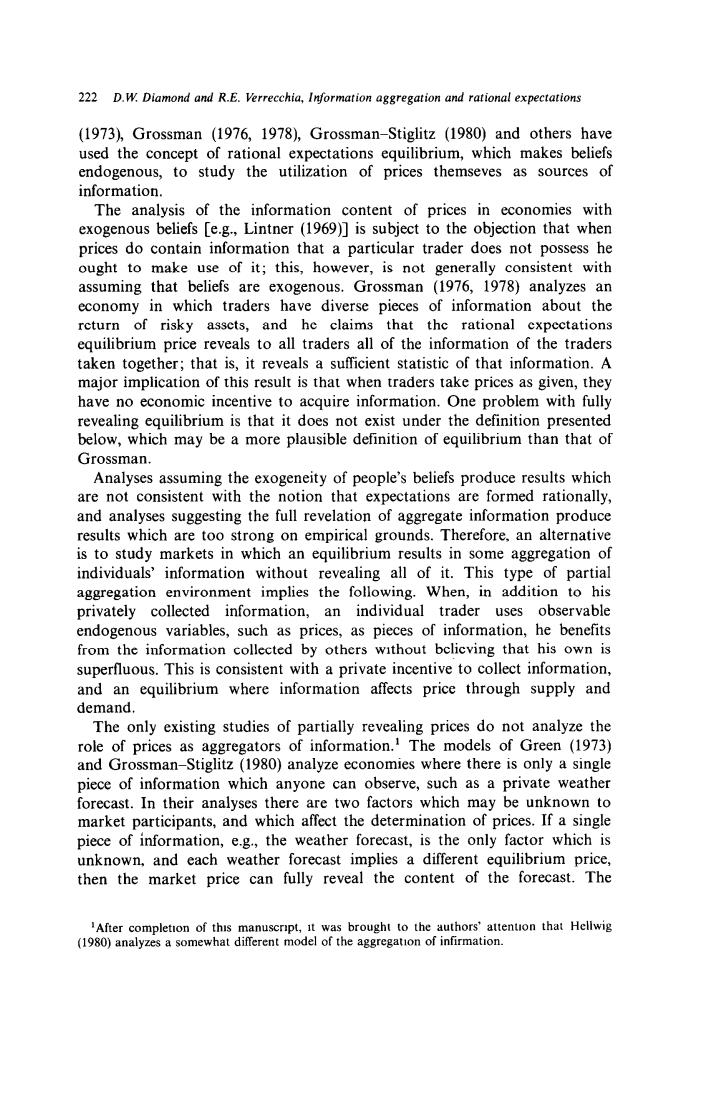正在加载图片...

222 D.W.Diamond and R.E.Verrecchia,Information aggregation and rational expectations (1973),Grossman (1976,1978),Grossman-Stiglitz (1980)and others have used the concept of rational expectations equilibrium,which makes beliefs endogenous,to study the utilization of prices themseves as sources of information. The analysis of the information content of prices in economies with exogenous beliefs [e.g.,Lintner (1969)]is subject to the objection that when prices do contain information that a particular trader does not possess he ought to make use of it;this,however,is not generally consistent with assuming that beliefs are exogenous.Grossman (1976,1978)analyzes an economy in which traders have diverse pieces of information about the rcturn of risky asscts,and he claims that the rational cxpectations equilibrium price reveals to all traders all of the information of the traders taken together;that is,it reveals a sufficient statistic of that information.A major implication of this result is that when traders take prices as given,they have no economic incentive to acquire information.One problem with fully revealing equilibrium is that it does not exist under the definition presented below,which may be a more plausible definition of equilibrium than that of Grossman. Analyses assuming the exogeneity of people's beliefs produce results which are not consistent with the notion that expectations are formed rationally, and analyses suggesting the full revelation of aggregate information produce results which are too strong on empirical grounds.Therefore,an alternative is to study markets in which an equilibrium results in some aggregation of individuals'information without revealing all of it.This type of partial aggregation environment implies the following.When,in addition to his privately collected information,an individual trader uses observable endogenous variables,such as prices,as pieces of information,he benefits from the information collected by others without bclicving that his own is superfluous.This is consistent with a private incentive to collect information, and an equilibrium where information affects price through supply and demand. The only existing studies of partially revealing prices do not analyze the role of prices as aggregators of information.The models of Green (1973) and Grossman-Stiglitz (1980)analyze economies where there is only a single piece of information which anyone can observe,such as a private weather forecast.In their analyses there are two factors which may be unknown to market participants,and which affect the determination of prices.If a single piece of information,e.g.,the weather forecast,is the only factor which is unknown,and each weather forecast implies a different equilibrium price, then the market price can fully reveal the content of the forecast.The 'After completion of this manuscript,it was brought to the authors'attenton that Hellwig (1980)analyzes a somewhat different model of the aggregation of infirmation.222 D.W Diamond and R.E. Verrecchia, Information aggregation and rational expectations (1973), Grossman (1976, 1978), Grossman-Stiglitz (1980) and others have used the concept of rational expectations equilibrium, which makes beliefs endogenous, to study the utilization of prices themseves as sources of information. The analysis of the information content of prices in economies with exogenous beliefs [e.g., Lintner (1969)] is subject to the objection that when prices do contain information that a particular trader does not possess he ought to make use of it; this, however, is not generally consistent with assuming that beliefs are exogenous. Grossman (1976, 1978) analyzes an economy in which traders have diverse pieces of information about the return of risky assets, and he claims that the rational expectations equilibrium price reveals to all traders all of the information of the traders taken together; that is, it reveals a sufficient statistic of that information. A major implication of this result is that when traders take prices as given, they have no economic incentive to acquire information. One problem with fully revealing equilibrium is that it does not exist under the definition presented below, which may be a more plausible definition of equilibrium than that of Grossman. Analyses assuming the exogeneity of people’s beliefs produce results which are not consistent with the notion that expectations are formed rationally, and analyses suggesting the full revelation of aggregate information produce results which are too strong on empirical grounds. Therefore, an alternative is to study markets in which an equilibrium results in some aggregation of individuals’ information without revealing all of it. This type of partial aggregation environment implies the following. When, in addition to his privately collected information, an individual trader uses observable endogenous variables, such as prices, as pieces of information, he benefits from the information collected by others without believing that his own is superfluous. This is consistent with a private incentive to collect information, and an equilibrium where information affects price through supply and demand. The only existing studies of partially revealing prices do not analyze the role of prices as aggregators of information.’ The models of Green (1973) and Grossman-Stiglitz (1980) analyze economies where there is only a single piece of information which anyone can observe, such as a private weather forecast. In their analyses there are two factors which may be unknown to market participants, and which affect the determination of prices. If a single piece of information, e.g., the weather forecast, is the only factor which is unknown, and each weather forecast implies a different equilibrium price, then the market price can fully reveal the content of the forecast. The ‘After completion of this manuscript, It was brought to the authors’ attention that Hellwig (1980) analyzes a somewhat different model of the aggregation of infkmation